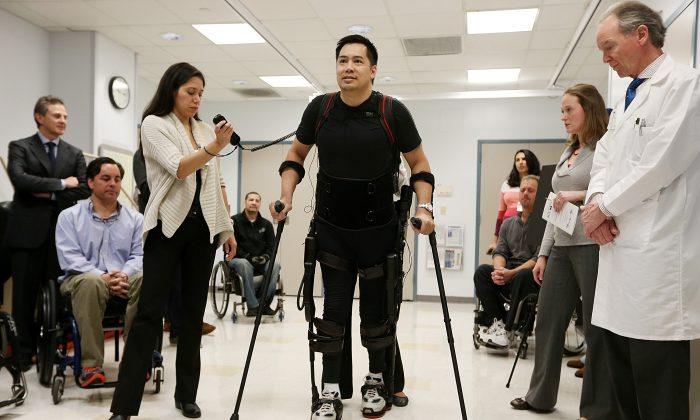Power exoskeletons—robotic suits that can greatly augment its wearer’s ability to lift and move things around—are already being developed for construction and factory workers, where the tools can promise to greatly multiply the productivity of a single worker.
In a separate field, robotic exoskeletons are looking to make a qualitative difference: help the physically disabled regain their motor functions and liberate the wheelchair-bound.
With the development of surgically implanted nerve stimulant devices over the past few years, it was thought this would be the only way to help people with severe paralysis regain use of limbs. But that belief was shattered a few months ago when researchers pioneered a noninvasive spinal cord stimulation technique to stimulate the muscles of paralyzed patients.
Now that technique is being paired up with robotic exoskeletons to allow previously paralyzed patients to walk without assistant of other people. Researchers at UCLA applied spinal cord stimulation to Mark Pollack, who had lost control of his legs four years ago after an accident. Pollack was strapped to an exoskeleton that augmented walking, so that he could independently exert the muscles used for walking.
In addition to the electrical stimulation, Pollack also had to take the psychoactive drug buspirone to make his nerves more sensitive.
The combined spinal-stimulation and exoskeleton therapy gave Pollack the feelings of tension and tingling, and he experienced heavy sweating on his legs and lower back, something that hasn’t happened since his accident, marking a major breakthrough in the field. Pollack also experienced elevated blood pressure and his heartbeat rose from 75 to 115 beats per minute.
https://www.youtube.com/watch?v=tPej2l6dVbw
“This is a great example of a therapeutic approach that combines two very different modalities—neuromodulation and robotic assist devices—to achieve a result that could not be realized with either approach alone,” said Grace Peng, Ph.D., director of NIBIB’s Rehabilitation Engineering Program, which had funded the research, in a statement.
The mechanized suit used by Pollack is produced by Ekso Bionics, which has been marketing its exoskeletons to physical therapy clinics. A key feature of Ekso’s bionic suit is that it can adjust the level of assistance it provides to the wearer on a sliding scale of 1 to 100 by changing the “variable assist” setting.
Apart from being able to customize the level of assistance needed for an individual patient, the bionic suit can allow patients to simulate walking even when their capability is extremely limited, just by cranking up the assist level, providing a major psychological boost for physical therapy patients.
If codified into a standard therapeutic tool, the technique could transform the lives of millions of Americans. Six million Americans live with some sort of paralysis, almost a quarter of which from spinal cord injury.
The results of the experimental therapy was presented in late August at an annual conference at the Engineering in Medicine and Biology Society in Milan, Italy. V. Reggie Edgerton, a senior author of the study, earlier stated that noninvasive spinal stimulation could be 10 times cheaper than its surgical counterpart.
Edgerton isn’t promising that this method will be a silver bullet for those suffering from complete paralysis, but considers it a major step forward nonetheless.
“It will be difficult to get people with chronic, complete paralysis to walk completely independently, but even if they don’t accomplish that, the fact they can assist themselves in walking will greatly improve their overall health and quality of life,” he said in a statement.
“For people who are severely injured, but not with complete paralysis, there’s every reason to believe they could improve even more with these types of interventions,” Edgerton added.





